
TNU Journal of Science and Technology 230(04): 111 - 119
http://jst.tnu.edu.vn 111 Email: jst@tnu.edu.vn
ENGLISH PRACTICE SPACES FOR GLOBAL MOBILITY: A CASE STUDY
OF AN INTERNATIONALLY ORIENTED UNIVERSITY IN VIETNAM
Pham Huy Cuong
*
Ho Chi Minh City University of Economics and Finance
ARTICLE INFO ABSTRACT
Received:
04/12/2024
English language teaching and learning takes an essential role in
internationalizing higher education. In Vietnam, tertiary institutions
have striven to elevate students’ English proficiency as a solid
package for their global mobility. Through the case study of a private
university with an international orientation, this study aims to explore
the spaces for English practice deployed at this institution and
teachers’ perceived constraints on such environments. This study
drew on a critical analysis of language-
related policies, annual
internal reports and website posts, and interview data with 10 full-
time English teachers at the university. Findings reveal abundant
opportunities and spaces for language practice that reiterated the
significance of English in its internationalization pursuit. However,
the teachers noted many limitations impeding such efforts concerning
student engagement, individualized support, and alignment with
internationalization. This study provides practical implications for
administrat
ors, language program developers and teachers in creating
more ample spaces for language practice and ensuring the
effectiveness and efficiency of such platforms.
Revised:
04/3/2025
Published:
04/3/2025
KEYWORDS
Language practice spaces
Internationalization
Out-of-class English learning
Student engagement
Global mobility
KHÔNG GIAN THỰC HÀNH TIẾNG ANH ĐÁP ỨNG HỘI NHẬP TOÀN CẦU:
NGHIÊN CỨU TRƯỜNG HỢP CỦA MỘT TRƯỜNG ĐẠI HỌC TƯ THỤC
THEO ĐỊNH HƯỚNG QUỐC TẾ TẠI VIỆT NAM
Phạm Huy Cường
Trư
ờ
ng Đ
ạ
i h
ọ
c Kinh
t
ế
-
Tài
c
hính Thành ph
ố
H
ồ
Chí Minh
THÔNG TIN BÀI BÁO TÓM TẮT
Ngày nhận bài:
04/12/2024 Việc dạy và học tiếng Anh đóng vai trò thiết yếu trong quá trình quố
c
tế hóa giáo dục đại học. Các trường đại học Việt Nam không ngừ
ng
cải thiện trình độ tiếng Anh của sinh viên nhằm nâng cao khả
năng
hội nhập của sinh viên. Thông qua phân tích trường hợp một trườ
ng
đại học tư thục theo định hướng quốc tế, nghiên cứu này nhằ
m tìm
hiểu các không gian thực hành tiếng Anh tại trường và quan điểm củ
a
giáo viên về các mặt hạn chế của các hoạt động này. Nghiên cứ
u
phân tích các chính sách ngôn ngữ, báo cáo nội bộ thườ
ng niên, bài
đăng trên web của trường và dữ liệu phỏng vấn với 10 giả
ng viên cơ
hữu. Kết quả cho thấy các không gian thực hành rất phong phú, nhấ
n
mạnh tầm quan trọng của tiếng Anh trong mục tiêu quốc tế hóa củ
a
trường. Tuy nhiên, các giảng viên chỉ ra một số hạn chế liên quan đế
n
mức độ tham gia của sinh viên, việc hỗ trợ từ
ng cá nhân sinh viên và
sự tương thích với mục tiêu quốc tế hóa. Nghiên cứ
u này giúp các
nhà quản lý, nhà phát triển chương trình và giảng viên tiế
ng Anh
trong việc đa dạng hóa không gian thực hành ngoại ngữ và đảm bả
o
tính hi
ệ
u qu
ả
c
ủ
a nh
ữ
ng n
ề
n t
ả
ng này.
Ngày hoàn thiệ
n:
04/3/2025
Ngày đăng:
04/3/2025
TỪ KHÓA
Không gian thực hành ngoại ngữ
Quốc tế hóa
Học tiếng Anh ngoài giờ học
Sự tham gia của sinh viên
Hội nhập toàn cầu
DOI: https://doi.org/10.34238/tnu-jst.11652
Email: cuongph@uef.edu.vn

TNU Journal of Science and Technology 230(04): 111 - 119
http://jst.tnu.edu.vn 112 Email: jst@tnu.edu.vn
1. Introduction
With its escalating role as a lingua franca, English plays a central role in mediating socio-
economic, scientific and education exchanges among countries worldwide. In Vietnam, the
unequivocal positioning of English has been articulately stated in its educational law and
language policies, and consistently ascertained at different levels of education, particularly in the
context of higher education (HE) [1]. Upgrading the English language proficiency level of
academics and students is a step forward for internationalization in higher education [2]. English
is also part of the indispensable package for higher employability among university graduates in
the context of globalization [3]. However, Hoang [4] observes that the English language
proficiency of the majority of Vietnamese students completing undergraduate education fails to
meet the market demands for workplace communication. This contributes to the growing concern
for the development of language competence among students, driving the efforts to reform
language policies and curricula in Vietnam [1].
Contemporary research has shown ongoing interest in English language education in tertiary
institutions in Vietnam in the context of HE internationalization. Hoang [4] emphasizes the need
to “rethink of the roles of English in the development of higher education in Vietnam”. In
response to the rapid shifts in the global and local educational settings, universities in Vietnam
have made radical changes to the curricula and language of communication in classrooms. The
widespread adoption of English as a medium of instruction at most HE institutions has posed
many problems concerning lecturers’ and students’ linguistic readiness for participating in such
learning environments [5]. As such, there exists an everlasting need for reviewing language
policies and diversifying spaces for language practice to elevate students’ English language
competence in tackling such contextual challenges [6], [7].
To optimize the efficiency of these processes, both formal and informal learning spaces have
been found to be rewarding and conducive to students’ language development [8], [9]. Formal
settings for language learning are primarily restricted to traditional classrooms and learning
spaces on campus. With the burgeoning of educational technology and the aftermaths of the
covid-pandemic, formal learning spaces extends to digital and virtual platforms endorsed by HE
institutions [10]. On the contrary, informal learning settings “embody specific forms of sociality,
co-presence and social support” that are attributable to students’ engagement in learning outside
school [11]. In this way, Richards [8] presents a list of informal learning spaces such as chat
rooms, self-access centers, language villages, digital games, and social media in which social
interaction is the central conduit for language practice. These spaces altogether provide students
with rich exposure to language resources and learning opportunities drawing on their
circumstances within and beyond classrooms.
While there has been a high volume of research on the benefits of learning in both formal and
informal learning spaces [12], [13], studies delving into the ways in which a specific HE
institution deploys promotes the status of English in its pursuit of internationalization remain
limited. This study aims to explore the language practice spaces at an internationally oriented
private university and teachers’ perspectives on the constraints hindering the effectiveness of
such environments. It contributes to enriching understandings of the ways in which specific HE
institutions have striven to expand English-related spaces and opportunities for global mobility.
The insights from this case study enable administrators and language program developers to
revisit and revise their own policies and practices to empower their students with strategies for
efficiently utilizing the learning resources available within and across multiple learning settings.
The present study is guided by the following research questions:
RQ1: What are the language practice spaces offered by the university to support its
internationalization orientation?
RQ2: What are teachers’ perceived constraints of these language practice spaces?

TNU Journal of Science and Technology 230(04): 111 - 119
http://jst.tnu.edu.vn 113 Email: jst@tnu.edu.vn
2. Methodology
2.1. Research setting
This study draws on a case study of a private multidisciplinary university in Ho Chi Minh
City that aims to provide students with an international standard of education in its strategic
development. One of the core values underpinning its operations is to comprehensively integrate
into the global context in its internationalization pathway. The university offers 36 domestic
undergraduate programs in different fields of economics, business, finance, law, languages, IT
and communication, and seven collaborative programs with American and British universities.
There are approximately 450 academic staff with a large number of them graduating from
prestigious HE institutions overseas. Over 10 percent of the full-time lecturers are foreigners who
are native speakers of English or fluent in the language. The university has developed long-
standing partnerships with universities from different parts of the world and is continuously
looking for new international partners.
The university provides an intensive General English Program (GEP) for non-English majors.
The GEP comprises six courses with a total of 300 contact hours spanning the first 1.5 years of
their studies. 30% of the specialized courses are delivered in English as a medium of instruction.
For graduation, students are required to achieve an overall band of 5.5 and above in the IELTS
(International English Language Testing System) or equivalents in other international language
proficiency tests endorsed by the Ministry of Education and Training, and the Vietnamese
Standardized Test of English Proficiency (VSTEP). Together with the formal language courses,
the university hosts a wide range of spaces for practicing English (discussed in the findings).
2.2. Instruments and Data Analysis
There are two types of data supporting this study. Document analysis of six official
documents, 10 faculty reports and 108 website posts in the academic year 2023-2024 were
utilized to identify the language policies and spaces for language practice at the university. For
teachers’ perspectives, qualitative data was collected from interviews with 10 English teachers
working full-time at the university. These teachers were recruited voluntarily based on three
criteria including a minimum of three-year working experience, proactive involvement in out-of-
class English-related activities for students, and experience as student counselors or mentors in
international activities. The interview focused on the key issues impeding the implementation of
the language practice spaces at the university in its internationalization efforts. At the beginning
of each interview, the researcher presented the English-related spaces in Table 1 (see 3.1) to the
interviewee to facilitate their reflections and obtain valid responses.
The documents above were examined carefully by the researcher using a chain of keywords
such as English-related, student activities, out-of-class, language practice, internationalization.
The results are reported in 3.1 with specific inclusion criteria. The interview data was analyzed
thematically based on the six steps of analysis guided by [14]. Firstly, the researcher developed
familiarity with the data by reading and re-reading it, highlighting pieces of data concerning the
constraints of deploying language practice spaces at the university, and noting down preliminary
ideas. Secondly, the resulting ideas were synthesized and coded tentatively such as student
engagement, learning spaces, student needs, constraints, and internationalization. Thirdly,
potential themes were formulated from these codes such as issues related to student engagement
in language practice, internationally-oriented activities, teachers’ challenges in responding to
students’ language needs, and individual students’ practice styles. Fourthly, the resulting themes
were reviewed against the coded extracts to ensure their compatibility. Fifthly, the themes were
defined and labelled. Three major themes were identified from the interview data concerning the
issue of student engagement, individualized support for students, and alignment with the
internationalization process. The final stage involved producing a report of the chosen themes

TNU Journal of Science and Technology 230(04): 111 - 119
http://jst.tnu.edu.vn 114 Email: jst@tnu.edu.vn
with reference to the research questions and relevant literature.
3. Findings and Discussion
3.1. Spaces for English Language Practice at the University
Table 1. Description of English-related spaces at the university
No.
Spaces and Modes
Description
1
English seminars
(offline, online, on campus,
off campus)
These seminars help students develop language skills and test-taking
strategies for language proficiency tests such as IELTS and VSTEP.
2
ESP workshops
(offline, online, on campus,
off campus)
These workshops provide rich opportunities for students to develop ESP
vocabulary and English terminology in their specializations. This
contributes to enhancing their employability in international markets.
3 Speaking portfolios
(online, off campus)
Students in the GEP are rewarded with bonus marks for recorded videos of
their role play in English outside class hours.
4 Reading portfolios
(online, off campus)
Students in the GEP are rewarded with bonus marks for reading and
summarizing novels in English outside class hours.
5 Speaking forum
(offline, on campus)
The speaking forum takes place twice a week during the semester.
Students are provided with handouts on certain global issues for
discussion.
6 English contests
(offline, online, on campus)
The contests vary in forms and topics aiming to provide students with
opportunities to reflect on their language use. They include written
competitions, debates, eloquence, English speeches and creative works.
7
Student publication
(offline, online, on campus,
off campus)
Students are encouraged to write their research reports in English and
share their publications (e.g., research projects, journal articles, conference
proceedings, and posters) at the annual student research symposium.
8
Cultural events
(offline, online, on campus,
off campus)
The university or individual faculties collaborate with international
universities, embassies or international associations in hosting events that
showcase cultural features of countries around the world.
9
Industry talks
(offline, online, on campus,
off campus)
Industry speakers are frequently invited to give talks in English to students
on a wide range of topics concerning their fields of expertise and
employability.
10 Lectures with international
scholars
The university hosts quite a large number of international scholars visiting
and giving lectures to students.
11
Overseas field trips
(offline, online, classroom-
based)
Faculties and the International Institute collaborate in organizing field trips
overseas during which students visit universities and businesses in other
countries.
12 Overseas internship
(offline, off campus)
The university has a strong network with international businesses and has
sent a large number of students overseas for internship.
13
Student exchange programs
(offline, on campus, off
campus)
The university and faculties collaborate with partnered universities in
hosting student exchange programs to enrich students academic and
cultural experiences.
14 Bilingual events (offline,
online, on campus)
The university encourages a combination of Vietnamese and English as
the language of communication during
all social and student events.
15
Bilingual programs
(offline, online, classroom-
based)
At least 30% of the courses are delivered in English. These courses are
mostly taught by foreign lecturers and qualified Vietnamese ones.
16 Collaborative programs
(offline, classroom
-
based)
Currently there are seven collaborative programs with American and
British universities. All courses in these programs are delivered in English.
17 Mock interviews
(offline, on campus)
Students are encouraged to participate in mock interviews with
international businesses in English. These events are held twice a year for
all senior students.
18 Mock tests (offline, online,
on campus)
The university and faculties collaborate with language centers and test
organizers in administering mock language tests for students.

TNU Journal of Science and Technology 230(04): 111 - 119
http://jst.tnu.edu.vn 115 Email: jst@tnu.edu.vn
Table 1 presents the spaces for language practice at the university in its pathway to
internationalization. Three inclusion criteria for identifying these spaces are (1) they involve the
use of English as the language of communication or instruction, (2) they respond to the
university’s emphasis on internationalization, and (3) they are additional spaces outside the GEP.
Table 1 reveals the diverse spaces for language practice at the university aiming to enrich
students’ opportunities for using English within and beyond campus. These activities accompany
the students throughout their academic journey and embrace the four essential language skills as
well as strategies for learning, test-taking, and global integration. These spaces cover different
stages at the university, from the time students are in the GEP to their final stages of internship
and preparation for entering the labor market. Unlike the frequently discussed out-of-class
learning activities in contemporary research in which students actively sought learning resources
and opportunities for themselves on a personal or group basis [15]-[18], the language practice
spaces presented in this study are organized systematically, drawing on a wide range of local and
global resources and platforms. Further, the combination of classroom-based, on- and off-campus
settings, and offline and online platforms caters to the need of more students who might not have
been able to attend such events if they had been organized offline and on campus only. This
traversal of learning spaces, as Lai [12] points out, contributes to forming “an ecology
comprising various dynamic and interdependent elements, and these formal, non-formal and
informal learning elements interact with each other to form an individual’s learning experience”.
3.2. Teachers’ Perceived Constraints of English-Related Spaces
3.2.1. Students’ low levels of engagement
Engagement refers to students’ cognitive, emotional and behavioral involvement in the
learning process [19]. This study focuses primarily on the behavioral tenet of engagement that
embraces proactive participation in various learning spaces. Student engagement in English-
related activities at the university exhibits three major problems: low levels of interest, lack of
attention, and reward-oriented participation. Many teachers reported that their students were
loosely engaged in the seminars, workshops and competitions organized for language practice.
For example, Teacher 1 stated, “Only a few students in my class join language practice activities.
Generally speaking, not many of them have shown their interest”. Similarly, Teacher 3
commented, “If we compare the number of attendees with the total students at our university, this
figure is rather humble, only accounting for a minor percentage. Faculties are trying their best to
encourage them but the students are not keen at all”. Such a reality confirms the interplay
between behavioral engagement and emotional factors such as interest and enjoyment [20], [21].
Those students who actually attended the events could be classified into three groups. While
some saw the learning opportunities from the language spaces at the university, others were
present with limited involvement or driven by external rewards such as bonus marks. Teacher 2
complained, “I noticed that students were distracted by smartphones or laptop computers or had
personal conversations. They came mostly for the bonus marks or student performance
evaluation”. As part of the university culture, the students had to attend social events contributing
to their performance evaluation at the end of each semester. This became one of the main sources
of stimulation for them. In other words, their involvement in these spaces was not for the sake of
language practice but rather for other unrelated reasons. Having the same observation, Teacher 4
noted, “While some high achieving students joined the English forum for more practice
opportunities, those low achievers stayed for about half an hour just for bonus marks”. Such
superficial participation is consistent with findings in other studies that learner engagement is
affected by intrinsic and extrinsic motivators, impeding the quality of their engagement [21].
In summary, the findings reveal students’ different levels of engagement in the language
practice spaces available at the university. The rate of participation remained limited given the

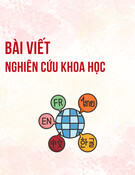

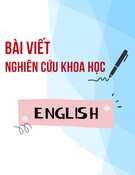
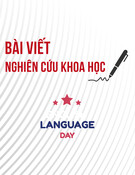
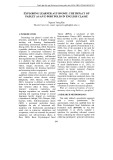
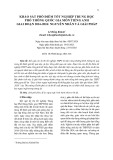
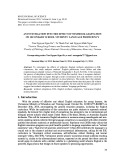
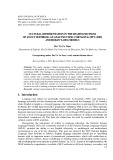
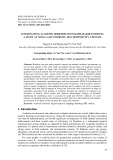



![Từ vựng tiếng Anh về thức ăn và giảm cân [mới nhất, đầy đủ]](https://cdn.tailieu.vn/images/document/thumbnail/2025/20251217/nglinh.diamond@gmail.com/135x160/53091766028543.jpg)

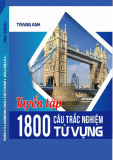
![Tài liệu Từ vựng tiếng Anh Trung cấp [mới nhất]](https://cdn.tailieu.vn/images/document/thumbnail/2025/20250913/nguyentuan250421@gmail.com/135x160/99491757910839.jpg)
![Tài liệu Từ vựng Tiếng Anh theo chủ đề [mới nhất]](https://cdn.tailieu.vn/images/document/thumbnail/2025/20250913/namdhuet@gmail.com/135x160/83251757753810.jpg)

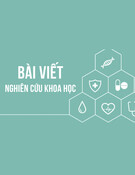

![Tài liệu Từ vựng tiếng Anh cho bé [chuẩn nhất/mới nhất]](https://cdn.tailieu.vn/images/document/thumbnail/2025/20250731/huadaithesang2509@gmail.com/135x160/18631754013896.jpg)




